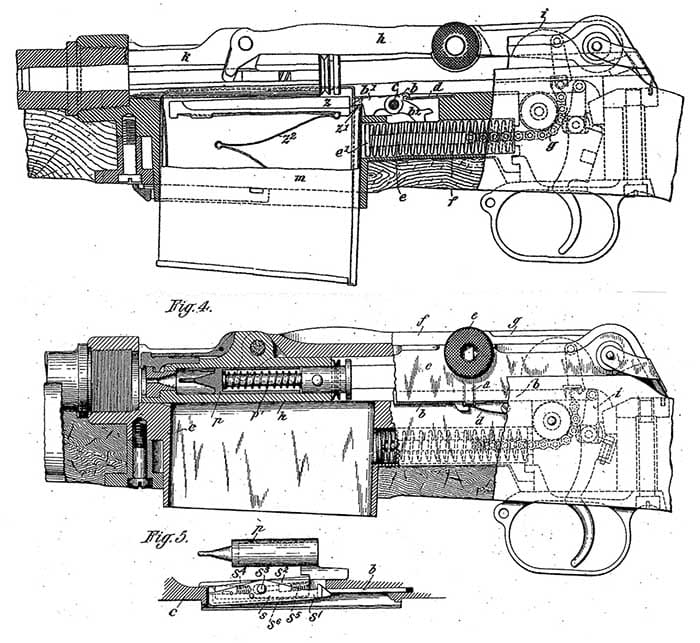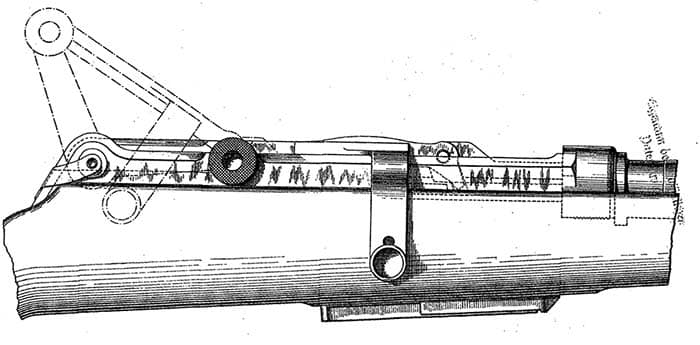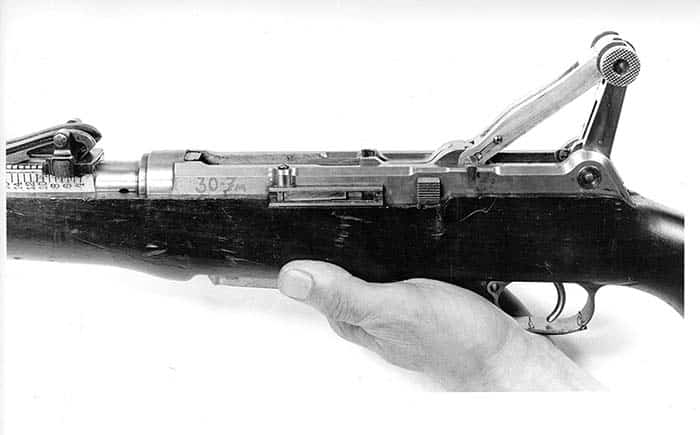In the 1990s, the arms collector’s world was excited by the discovery of a Luger self-loading rifle with a toggle-lock, developed shortly before World War I. Here is something more unique: a prototype Borchardt toggle-lock rifle from that same period.
For most of their lives, weapon designers Hugo Borchardt (1844–1924) and George Luger (1849–1923) were fierce competitors. It is, of course, well known that both were involved in the early stages of development of a self-loading pistol, with Luger modifying Borchardt’s original design into the famed Parabellum pistol. It is far less well known that both Luger and Borchardt occupied themselves with the design of a semi-automatic rifle shortly before the outbreak of World War I.
Until the 1990s, there were mostly rumors and scraps of information, but then there was a spectacular find: a semi-automatic Luger rifle with a toggle-lock, serial number 4, in the German military caliber 7.92×57. The weapon reportedly emerged in Britain in the amnesty of 1988 and finally ended in the collection of arms dealer Samuel Cummings. For a long time, it was debated whether this was an original gun or a very clever forgery, but eventually the weapon turned out to be genuine and a number of associated patents were found.

A bit dirty and damaged, but still a most wonderful find: the Borchardt semi-automatic rifle!
Lawsuit
The veil was lifted further when a part of Georg Luger’s estate was bought by a European collector. Among the personal papers were documents concerning a lawsuit in 1920 between Luger and his former employer, Deutsche Waffen- und Munitionsfabriken (DWM). Luger could never quite get along with the general manager of DWM, Paul von Gontard. Disagreements eventually ran so high that Luger was fired. That, in itself, did not bother him. He objected, however, to the fact that DWM claimed the rights to the semi-automatic rifle he had developed.
One of the documents that Georg Luger presented to the court was a letter from the Prussian War Department in Berlin to DWM, dated March 2, 1914, in which the ministry expressed its interest in further tests with the Luger rifle. The same letter gave a less favorable opinion on another gun offered by DWM for trials: a Borchardt semi-automatic rifle.
Deficiencies
The Prussian authorities considered the 4.8-kilogram Borchardt rifle too heavy and difficult to disassemble. In addition, it was found to have several mechanical defects. The weapon had a toggle-lock combined with a fixed barrel. The result was that the breechblock would already begin its rearward movement when the bullet was still in the barrel, so that part of the cartridge case had to withstand the full gas pressure. The toggle joint that slammed to the rear was considered potentially dangerous to the shooter, especially when kneeling or in the prone position (which, by the way, was equally true for Luger’s gun).
The toggle-lock of the Borchardt rifle operated under the pressure of a heavy coil spring, which was located longitudinally behind the magazine. The force of the spring was transferred to the toggle-lock through a chain, as shown in Borchardt’s German patent 241,941 and U.S. patent 1,160,831. The Prussian War Ministry did not like this construction. Installation and removal of the chain was too complicated for the ordinary soldier, and the links collected dirt and dust. Finally, the self-loading mechanism did not work with blank cartridges.

Two drawings of the Borchardt rifle. The top one is from German patent 241,941 from March 1, 1911. The lower one is from U.S. patent 1,160,831, for which the application was filed on February 2, 1914. There are slight differences. The German drawing, for instance, shows the details of the magazine catch.
Where, Oh Where?
The letter from the War Ministry provides indisputable evidence that the Deutsche Waffen- und Munitionsfabriken had offered both a Borchardt and a Luger self-loading rifle to the Prussian authorities for trials, prior to World War I. The Luger gun had already surfaced. But where was the Borchardt rifle? Quests for this unique piece at first only yielded a series of patents, issued from May 1908 onward:
DRP 213,012 from May 17, 1908;
DRP 241,941 from March 1, 1911;
DRP 262,217 from February 11, 1912;
DRP 262,217 from April 17, 1912;
DRP 279,184 from February 22, 1914.
The rifle is best illustrated in German patent 241,941, and in U.S. Patent 1,160,831 for which the application was filed on February 2, 1914. Both are reproduced here, showing small differences in the artwork.
However, all this did not answer the most important questions: Had the Borchardt self-loading rifle survived? And, if so, where? As can be seen from the pictures, we can answer that question: A prototype does exist, and it is in the collection of the Museum of Artillery, Engineers and Signal Corps in St. Petersburg, Russia.

With such a huge toggle-lock and a strong mainspring, cocking the Borchardt rifle was quite a challenge. German patent 279,184, granted February 22, 1913, provided a separate cocking handle.
Description
The weapon in the museum is similar in almost all respects to the drawings of the German and U.S. patents. The gun is unnumbered, in the white (like many prototypes) and has no visible markings. It lacks both Borchardt’s name and the DWM logo, and it has no proof marks. Apart from some minor damage, the metal is in good condition, but the stock has suffered considerably. As can be seen in the pictures, the wood is full of dents and scratches. The only missing part is the leaf spring that secures the barrel band.
At first sight, the Borchardt rifle looks like the front of a Gewehr 98 has been combined with the rear of a Garand, with the toggle of the Parabellum pistol. The Borchardt rifle has a detachable magazine with a five-round capacity for the German standard 7.9×57 military cartridge. The magazine catch at the front of the magazine housing is U-shaped with two arms on either side of the magazine. The magazine is held in place by two studs on these arms, which fall in the small rectangular openings at the sides of the magazine. Pressing the catch to the rear forces the studs outwards and releases the magazine.

The Borchardt rifle with the toggle opened. Itís like a Parabellum pistol on steroids.
Knee Joint
The most spectacular part of the Borchardt rifle is, of course, the beautifully made toggle-lock, which resembles that of a Parabellum pistol on steroids. It must have been a difficult job to figure out the kinetics. The breechblock must move to the rear sufficiently, to be able to pick up and chamber a full-size 7.9×57 round, which means the toggle joint must open accordingly. The layout of the lock remained unchanged: first the breech block with a combined loaded chamber indicator and extractor in the top, and then the two joints of the toggle.
In order to prevent the breechblock from rebounding due to the blow against the back of the barrel, the left side of the receiver has a spring-loaded metal plate which falls into a recess in the left cocking knob. The left side of the receiver also has a sliding safety catch and a sear bar just like the Parabellum pistol.
So, you may ask, why are there no pictures of the internals of the gun? Well, there simply was no time to take them. The Museum of Artillery, Engineers and Signal Corps has a collection of about 60,000 firearms, which might well make it the largest museum collection in the world. When our small group was at the museum, we had just a few days. So, there was a choice: go into a few dozen guns in depth or photograph as many as possible. We chose the latter. So even if it’s a glimpse, it’s a glimpse of one of the rarest guns in the world: the Borchardt semi-automatic rifle.